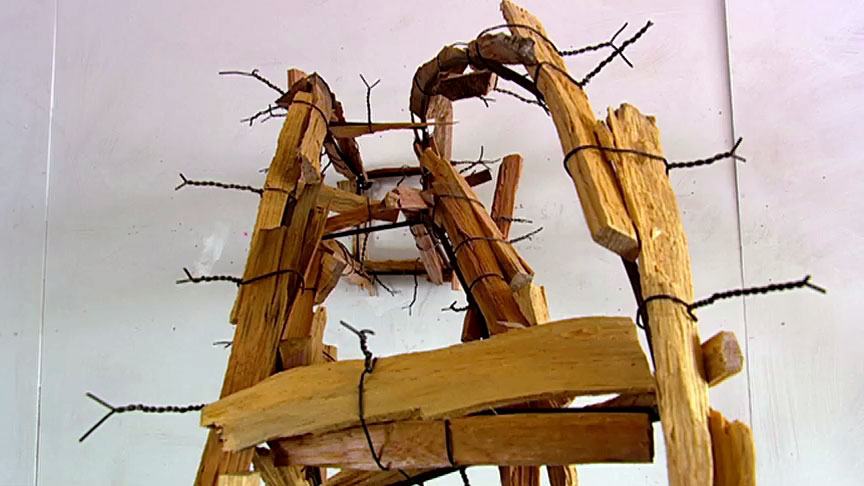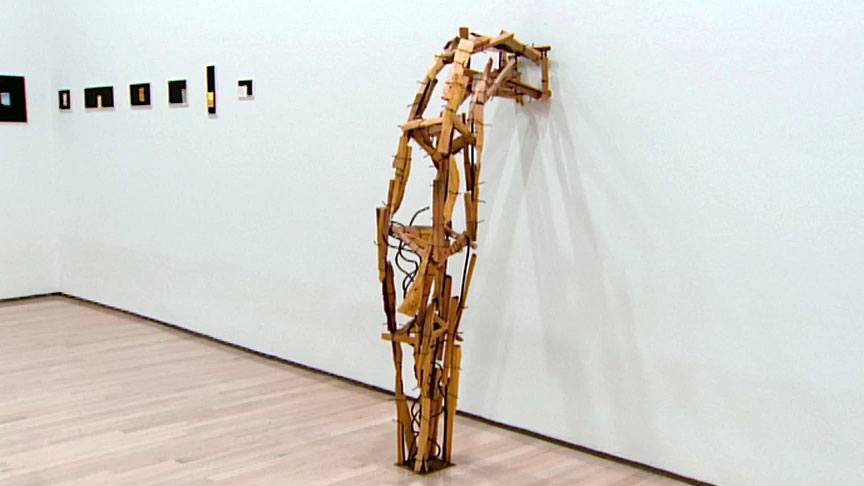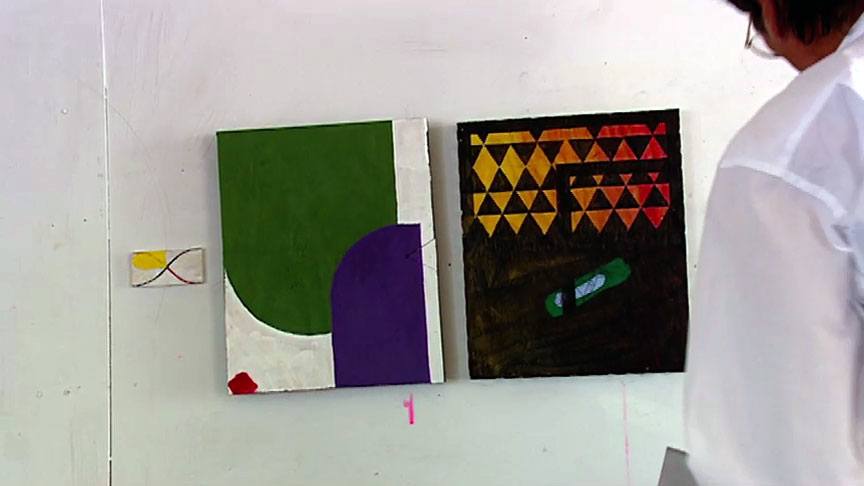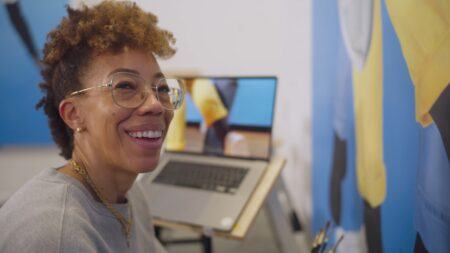Interview
Drawing & Exhibitions

Richard Tuttle works on Village I, Sculpture I (2004) in his studio, Abiquiu, New Mexico, 2004. Production still from the Art in the Twenty-First Century Season 3 episode, Structures, 2005. © Art21, Inc. 2005.
Richard Tuttle discusses his artistic process, as well as the role that personality and drawing play in his work.
ART21: What is this, in your studio?
TUTTLE: This is the sculpture for Village I, for The Drawing Center show next fall [2004]. Each village has two groups of drawings to it. The space of The Drawing Center will be divided up into these villages, so the viewer will probably be attracted to this large sculptural element because that’s what they’ll see. This village idea is a way to invite the visitor in, so that you’re not sent on a circuit or down corridors. You enter a room that you can scan in a second, and if you’re attracted, you can go in that direction. The sculptures function as a way to help you get into that drawing space, which is really intimate. It’s interesting because, in a materialist society, a lot of people have intimacy problems. Drawing becomes a little bit like a pure thing that can stay freer from some of the corrupting influences. Each set of drawings seems to concern itself with how the piece meets the floor, or how the piece meets the wall.
ART21: The village idea—can you say more about it?
TUTTLE: It’s just as if you were going to visit a village, like El Rito or Abiquiu in New Mexico. You go in, and each village takes on a personality. Cities usually form out of conglomerations of villages, so an exhibition might be likened to a city. You don’t need to go to all the places if you don’t care to, but you’re still welcome to roam around. I’ve been working on the show for almost two years, and it will be very rich in work. In a way, it would be enough for a visitor just to visit one village, but you have a choice. You might respond to one of these large pieces just because you like that color or you like that form, or so on. Then you can just go and see the drawings that are associated with that, and that might be enough.
On Monday, we’ll go down and see this textile exhibition that is experimenting with a lot of ideas about exhibition making: how you invite the visitor, what the visitor might experience, what they might take away, and what they might leave behind. For me, an exhibition is the best way I can get all the stuff I like or need—knowledge, experience, beauty—I can use my head, my heart, and my body. And to me, it’s a very valuable form in itself. I’m amazed that, in America, there are no real universities that teach about exhibition making. A great exhibition is something that’s made, and it takes a lot of experience, creativity, and positioning of objects in relationship to the viewer. It’s a person-to-person thing, where the curator connects with the visiting public through this material. If it’s done well, it’s very valuable, to me.

Richard Tuttle. Village I, Sculpture I (2004) installed at The Drawing Center, New York, 2004. Production still from the Art in the Twenty-First Century Season 3 episode, Structures, 2005. © Art21, Inc. 2005.
ART21: Talk about the process of making work.
TUTTLE: There’s the whole creative effort, where you really feel you’re outside of yourself: you get beyond this barrier that normally we live within. It’s happened a couple times in my life. I’ll look at something and say, “I did not make that” when all the evidence is to the contrary. My best friend will come in and say, “Now, that’s a real Richard Tuttle.” In some sense, that’s how a viewer would express a sense of being beyond themselves—like, “That’s a real Jackson Pollock” or “That’s a real Rembrandt.” In your heart, you know that you did go beyond yourself; you enjoyed this kind of a leap.
ART21: You think a lot about what drawing is.
TUTTLE: I put this enormous pressure on what drawing is, but I know it’s not the conventional way of thinking about drawing. Everything in life is drawing; drawing is such an enormous thing in itself. When I see a child pick up a pencil and piece of paper, my heart just leaps with expectation and excitement. Little kids are capable of making a drawing; I mean, every house in America has a drawing on their refrigerator.

Richard Tuttle hangs work from Village IV (2004) in his studio, Abiquiu, New Mexico, 2004. Production still from the Art in the Twenty-First Century Season 3 episode, Structures, 2005. © Art21, Inc. 2005.
ART21: How are these drawings challenging traditional notions of drawing?
TUTTLE: The Drawing Center is saying: “Art is unique because there’s a part of art that drawing is not part of.” So, I’m saying to the Drawing Center: “If you really are a drawing center and you really you know love drawings, then you love the bad side as well as the good side. But all for your entire history, you’ve only been showing this good side.” I want to make a show about the other side of drawing.
One might say that, in order to draw, you have to be able to see. Well, what about making drawings about an area you can’t see? Oddly enough the drawings that go with this piece have a part in them of what you can’t see. As obsessed as I am about the experience of seeing and details, what I find most interesting is the part that I can’t see. And that’s what I want to do: I just want to look at those kinds of places. For example Village III is in general about color, but in specific it’s about a certain color blue. Ask somebody to draw blue, to make a drawing of blue, you know. You can’t do that. It’s not linear, and it’s not even symbolic, not a concept, and it can’t be registered in any parallel notation. But there is some way, something you can do, to create the definition of what that drawing must do in the mind of the viewer or the maker that is equivalent to that color blue.
I’m not philosophically based, but you immediately get into areas where you ask, “Is that blue?” And that, indeed, gets us to this delicious subject of the wall and the floor—an old division between realism and idealism. In terms of blue—if we’re going to try to draw blue—then the concrete is going to contribute, and so is the ideal. But the division of the real and the ideal is, basically, about the ideal saying that the experience happens inside of you—which would mean that everything, from the conception of drawing to the color itself, is inside you—and the real saying that everything is outside you. I think the truth is that, yes, those are polarities that one can discuss, and they can be useful. But finally it’s art and art alone that can actually say what is the truth.
I was doing white paper octagons on a wall at a museum in Dallas. And the critic came along and made mock introductions, “Oh, this is Richard Tuttle. He’s interested in impermanence in the arts.” And she said that to Betty Parsons, and Betty just immediately snapped back, “What’s more permanent than the invisible?” It fits in with the whole line—that in any art form, there has to be an accounting of its opposite condition. If you’re going to be a visual artist, then there has to be something in the work that accounts for the possibility of the invisible, the opposite of the visual experience. That’s why it’s not like a table or a car or something. I think that that might even be hard for people because most of our visual experiences are of tables: it has no business being anything else but a table. But a painting or a sculpture really exists somewhere between itself, what it is, and what it is not—you know, the very thing. And how the artist engineers or manages that is the question.
This interview was originally published on PBS.org in September 2005 and was republished on Art21.org in November 2011.



